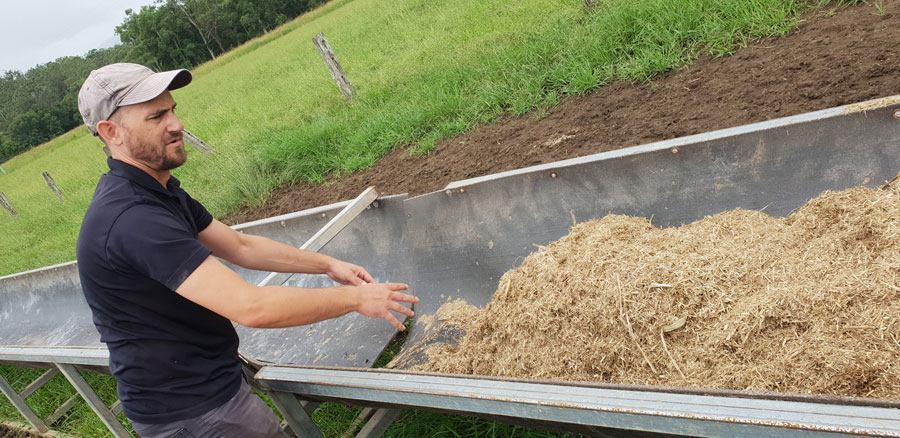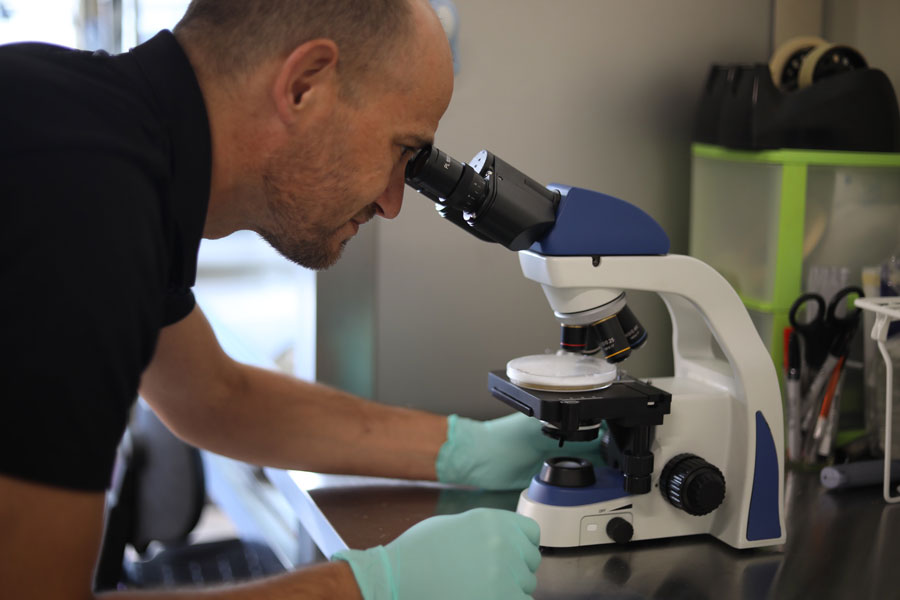Key points
- The company behind a process that converts sugar cane trash into high-value stockfeed is looking to partner with the grains industry
- Sustinent, the biotechnology start-up, is taking part in GRDC’s innovation program
- With Sunshine Sugar, Sustinent has built a pilot plantin northern NSW that converts sugar cane trash into a valuable stock feed commodity
Too thick to sow through, the high stubble loads often encountered in high-rainfall zones can be problematic. The need to deal with this excess stubble before the next crop is planted often means burning is used.
For Nick Patterson, farm manager of the Wirrinourt Pastoral Company, based at Mininera in south-western Victoria, this seems a waste. “Victoria’s high-rainfall zone produces up to 400,000 tonnes of stubble a year. We want to be on the front foot and find a solution to our high stubble load that uses this material before burning is banned.
“At Wirrinourt, high stubble loads are just too thick to sow through. The load also leads to slug issues, so we burn them but would like another economically viable option.”
It has led him to closely watch how a pilot plant on the northern NSW coast is performing. The plant is taking sugar cane trash and converting it into nutrient-rich stock feed. This is helping the sugar industry deal with waste and diversify its income stream.
 Excess grain stubble could also be converted into nutrient-rich stock feed. PHOTO: courtesy Philip Ellery
Excess grain stubble could also be converted into nutrient-rich stock feed. PHOTO: courtesy Philip Ellery
The 1000-tonne pilot production plant at Sunshine Sugar’s Harwood Mill site is potentially the first of many. In a process developed by biotechnology start-up Sustinent, lignocellulosic material, such as sugarcane trash, is converted into nutrient-rich stockfeed.
Sustinent founder and chief scientific officer Dr Philip Ellery says the process can also be used in the grains industry. He is keen to engage with grain growers about converting excess crop stubble in a similar way, transitioning the technology and business case to grain.
The biotech start-up has been part of the GRDC-supported Accelerator and GrainInnovate programs.
GRDC business development manager Tim Spencer says these programs allow GRDC to engage with and cost-effectively support innovation, particularly from partners that are developing technology that does not necessarily fit a traditional research project.
“Accelerators like AgriStart and Cicada, as well as Farmers2Founders and the Agtech and Logistics Hub, provide the business development support new innovators and entrepreneurs need.”
Innovation projects that value-add – by using crop stubble or grains that might not traditionally be viewed as food-grade, such as Whole Green Foods – are important because they support the grains industry, he says. This can be the result of helping to create new value for growers or in providing local employment or additional markets.
“The challenge is that these solutions need to be at the very least cost-neutral to the grower and preferably a positive revenue source. The accelerator programs provide frameworks, networks and accountability for these companies to properly test the market before commercialising their solutions.”
Trash to treasure
The Sunshine Sugar pilot plant comes after extensive laboratory work and a feasibility study, following a problem-solving search by Dr Ellery.
Dr Ellery won an Advance Queensland Founders Fellowship while working in commercialisation at Griffith University. The fellowship allowed him time to seek a problem and develop a solution.
He began by looking into agriculture. “The global agriculture and forestry sectors generate around five billion tonnes of green waste each year and it is largely underutilised. Not only is this a missed opportunity but when that waste is poorly managed, it can have a negative impact.”
Talks with NSW Sugar soon followed. “They had a problem with this trash and had tried energy co-generation but were also looking for other opportunities.”
Unlike in the cane-producing areas of North Queensland, cane trash does not degrade in the off-season in NSW. “This can add to disease load,” he says.
 Sustinent founder and chief scientific officer Dr Philip Ellery in the laboratory. PHOTO: courtesy Philip Ellery
Sustinent founder and chief scientific officer Dr Philip Ellery in the laboratory. PHOTO: courtesy Philip Ellery
In true start-up style, Dr Ellery began some Tupperware container experiments under his stairs before progressing to laboratory work, feasibility studies and now the pilot plant.
The process uses microbes, similar to those used to brew beer and make cheese, to convert tough and nutritionally void material into healthy, protein-rich animal feed. The process can also be potentially used to make other products, such as human-grade protein, and composite materials for the construction and packaging industries.
Although the new pilot plant has been built to suit Sunshine Sugar’s needs, it can be scaled to suit other green waste streams. With that in mind, he is keen to engage with grain growers, explaining the technology and business model.
“We are looking for early adopters, those forward-thinking growers in areas with a lot of excess biomass.”
GRDC grower relations manager (south) Tom Blake says high stubble loads can be a problem in high-yielding, high-rainfall zones. “Stubble can provide growers with the benefit of stored moisture retention, reduced wind erosion and soil organic matter. However, in other areas, the quantity of stubble can impact plant establishment and increase the risk of stubble-borne disease and pests.”
One of those interested in making the most of this excess biomass is Wirrinourt Pastoral Company’s Nick Patterson.
Nick says that in drought years, stubble can be sold for fodder at about $100 a tonne. “In a normal year, we can’t do this. The stubble is not needed. So, Sustinent could offer a cost-recovery option at a margin that would benefit our local industry.”
Keenly following the Sunshine Sugar pilot, Nick envisages local growers in his area baling stubble straight after harvest, storing it on-farm and supplying it throughout the year as a whole bale.
“Logistically, we don’t want to cart it more than 50 kilometres, so small pilot plants would work.”
Sustinent chief executive Peter Tomich says that although each approach will be different, Sustinent’s business model is to partner with industry players. “It’s their business and their waste. It’s about enabling others to capitalise on that resource, rather than us just buying that waste cheaply. We want it to be a partnering approach.”
More information: Dr Philip Ellery, 0411 653 554, philip.ellery@sustinent.com, Sustinent website

























































